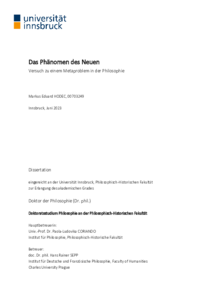Das Phänomen des Neuen
The phenomenon of the new
Fenomén nového. Pokus o metaproblém ve filozofii
dizertační práce (OBHÁJENO)

Zobrazit/
Trvalý odkaz
http://hdl.handle.net/20.500.11956/186904Identifikátory
SIS: 181340
Kolekce
- Kvalifikační práce [6713]
Autor
Vedoucí práce
Oponent práce
Stenger, Georg
Schmiedl-Neuburg, Hilmar
Fakulta / součást
Fakulta humanitních studií
Obor
Německá a francouzská filozofie
Katedra / ústav / klinika
Doktorský program Německá a francouzská filosofie
Datum obhajoby
16. 10. 2023
Nakladatel
Univerzita Karlova, Fakulta humanitních studiíJazyk
Němčina
Známka
Prospěl/a
Klíčová slova (česky)
Neu, das Neue, Känologie, καινός, νέος, Werden, Bewegung, Statik, Dynamik, Kontinuität, Bruch, Wiederkehr, Sprung, Fortschritt, Eschatologie, Totalität, Vorläufigkeit, Negation, Dia- lektik, Phänomenologie, Kreativität, Innovation, das Neue als Ware, Heraklit, Hegel, Husserl, AdornoKlíčová slova (anglicky)
New, the New, Kainology, καινός, νέος, becoming, movement, static, dynamic, continuity, break, return, leap, progress, eschatology, totality, provisionality, negation, dialectics, phenomenology, creativity, innovation, the New as a commodity, Heraclitus, Hegel, Husserl, AdornoDie vorliegende Arbeit am Phänomen des Neuen versteht sich als einleitender Aufbau der Kä- nologie. Damit verfolgt sie zwei Ziele. Einerseits handelt es sich um die Etablierung eines neuen philosophischen Begriffes und einer eigenständigen philosophischen Methode, der Känologie. Andererseits gilt der Hauptumfang dieser Untersuchung der erst beginnenden Problematisie- rung des Phänomens des Neuen. Um die systematische Betrachtung des Neuen vorzunehmen, ist die Arbeit in drei Abschnitte geteilt, die jeweils ein eigenes Teilergebnis hervorbringen. Der erste Abschnitt beschäftigt sich mit der Geschichte des Neuen. Exemplarisch Bezug nehmend auf die ontologische Opposition von Heraklit und Parmenides, weist das Neue sich als Phänomen aus, das präziser behandelt werden kann in Hinblick auf das Werden, anstatt in Hinblick das Sein. Der zweite Abschnitt widmet sich der Methode. Die känologische Methode stützt sich dabei einerseits auf die Dialektik, wie sie von Hegel formuliert und von Adorno weiterentwickelt wird. Anderseits bezieht Känologie Anleihen bei der Methode der Phänomenologie, namentlich der Husserlschen. Aus der gegenseitigen Ergänzung beider Pionierleistungen ergeben sich für die Känologie vier methodologische Hauptelemente: Erste Person Singular, Vom Datum zum Wesen, Das eingeschlossene Dritte und...
The present work on the phenomenon of the new sees itself as an introductory structure of kainology. In doing so, it is pursuing two goals. On the one hand, it seeks the establishment of a new philosophical concept and an independent philosophical method, kainology. On the other hand, the main scope of this investigation applies to the problematization of the phenomenon of the new. In order to take a systematic look at the new, the work is divided into three sections, each of which produces its own partial result. The first section deals with the history of the new. Exemplifying the ontological opposition of Heraclitus and Parmenides, the new emerges as a phenomenon that can be treated more precisely in terms of becoming rather than in terms of being. The second section is dedicated to the method. The kainological method is based on the one hand on dialectics as formulated by Hegel and further developed by Adorno. On the other hand, kainology borrows from the method of phenomenology, namely Husserl's. The complementarity of the two pioneering achievements results in four main methodological elements for kainology: first person singular, from fact to Wesen, the included middle and subject-object. After the history of the new has been traced and the method of kainology established, it is time to examine the...
